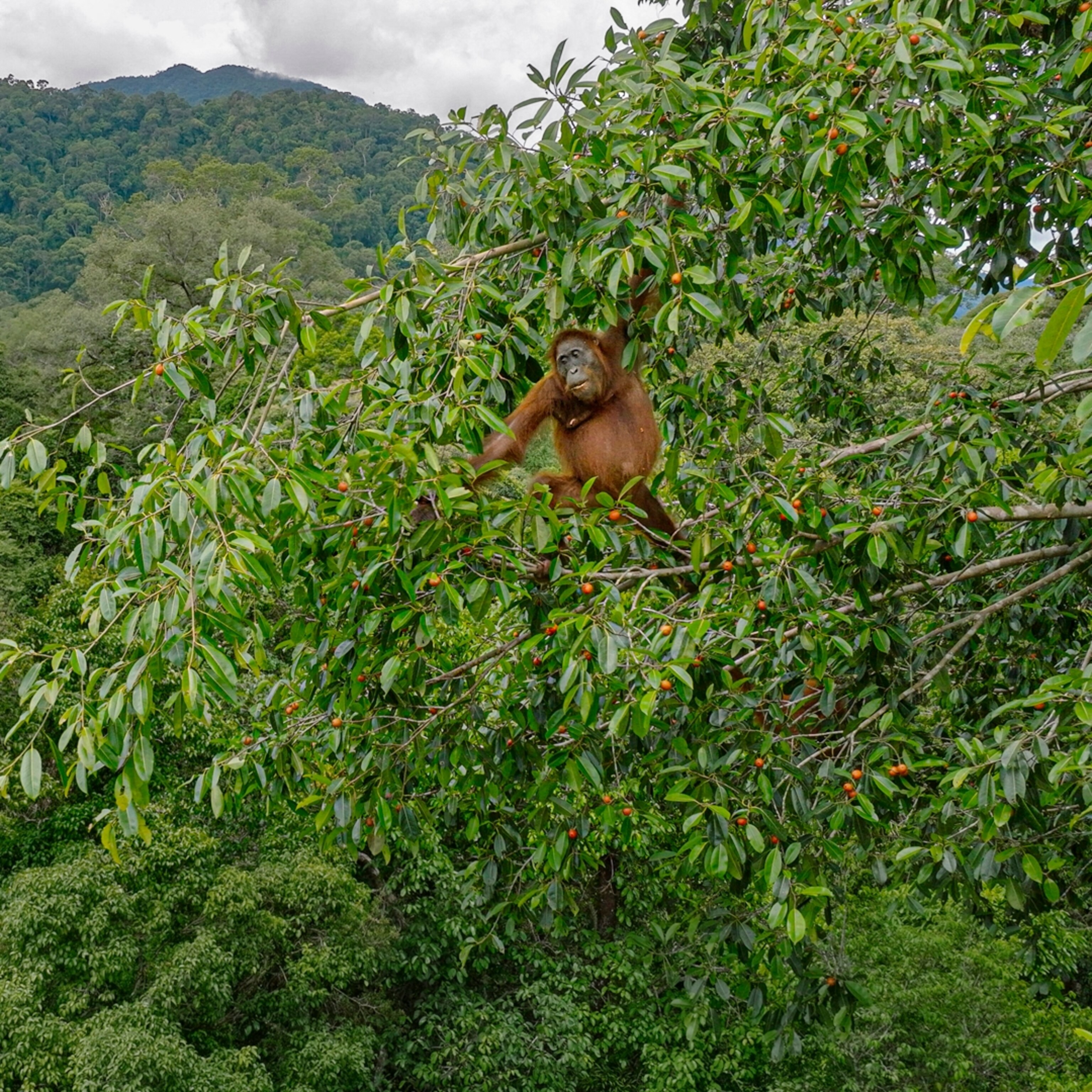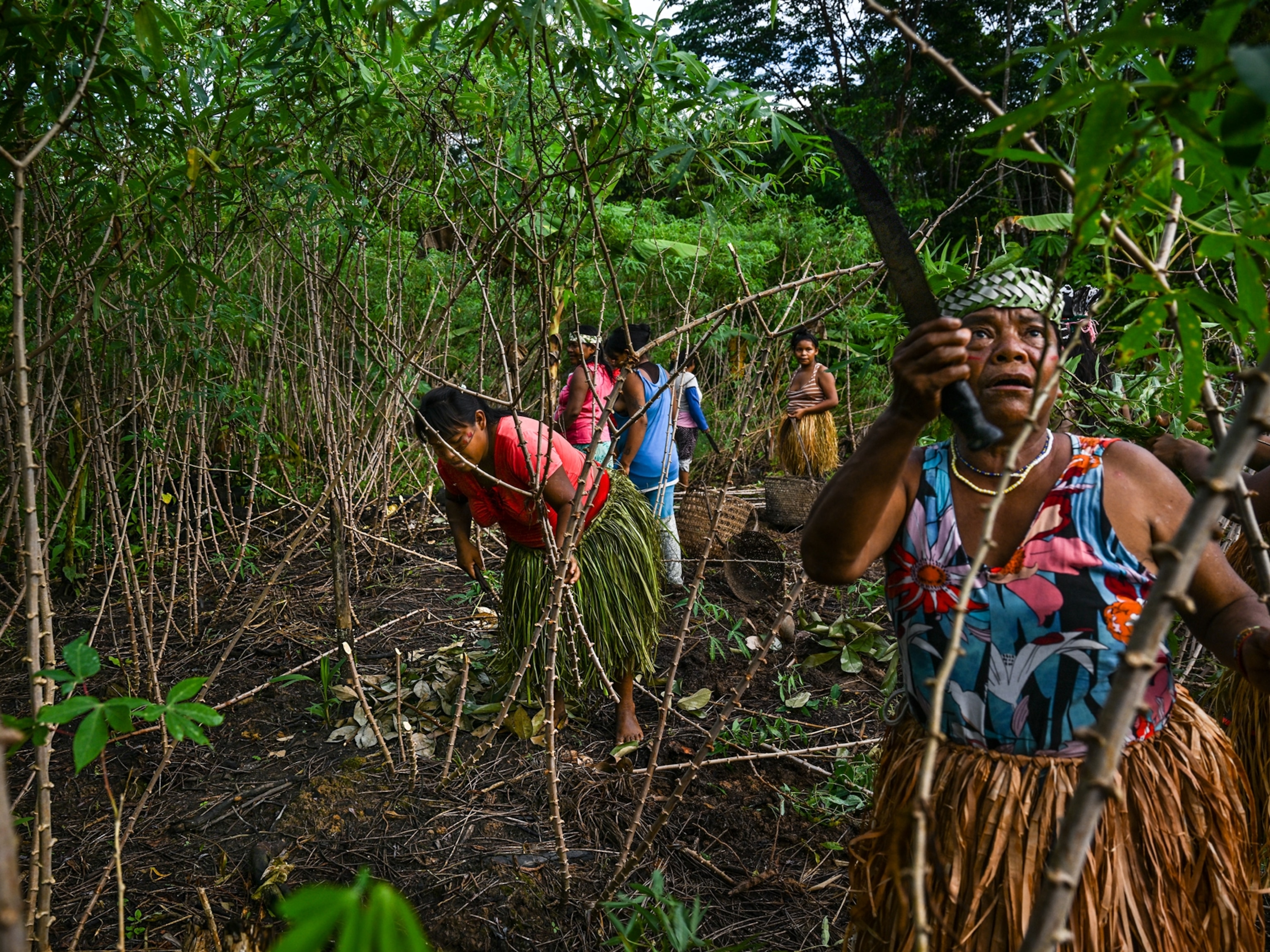
First study of all Amazon greenhouse gases suggests the damaged forest is now worsening climate change
The first broad look at all of the gases that affect how the Amazon works—not just CO2—reveals a system on the brink.
The Amazon rainforest is most likely now a net contributor to warming of the planet, according to a first-of-its-kind analysis from more than 30 scientists.
For years, researchers have expressed concern that rising temperatures, drought, and deforestation are reducing the capacity of the world’s largest rainforest to absorb carbon dioxide from the atmosphere, and help offset emissions from fossil-fuel burning. Recent studies have even suggested that some portions of the tropical landscape already may release more carbon than they store.
But the inhaling and exhaling of CO2 is just one way this damp jungle, the most species-rich on Earth, influences the global climate. Activities in the Amazon, both natural and human-caused, can shift the rainforest’s contribution in significant ways, warming the air directly or releasing other greenhouse gases that do.
Drying wetlands and soil compaction from logging, for example, can increase emissions of the greenhouse gas nitrous oxide. Land-clearing fires release black carbon, small particles of soot that absorb sunlight and increase warmth. Deforestation can alter rainfall patterns, further drying and heating the forest. Regular flooding and dam-building releases the potent gas methane, as does cattle ranching, one chief reason forests are destroyed. And roughly 3.5 percent of all methane released globally comes naturally from the Amazon’s trees.
Yet no team had ever tried to assess the cumulative impact of these processes, even as the region is being rapidly transformed. The research, supported by the National Geographic Society and published today in Frontiers in Forests and Global Change, estimates that atmospheric warming from all of these sources combined now appears to swamp the forest’s natural cooling effect.
“Cutting the forest is interfering with its carbon uptake; that’s a problem,” says lead author Kristofer Covey, a professor of environmental studies at New York’s Skidmore College. “But when you start to look at these other factors alongside CO2, it gets really hard to see how the net effect isn’t that the Amazon as a whole is really warming global climate.”
The damage can still be reversed, he and his colleagues say. Halting global emissions from coal, oil, and natural gas would help restore balance, but curbing Amazon deforestation is a must, along with reducing dam building and increasing efforts to replant trees. Continuing to clear land at current rates appears certain to make warming worse for the entire world.
“We have this system that we have relied on to counter our mistakes, and we have really exceeded the capacity of that system to provide reliable service,” says co-author Fiona Soper, an assistant professor at McGill University.
A complicated ledger
The same richness that makes the Amazon so wonderfully biodiverse, home to tens of thousands of insects per square mile, makes understanding it extremely hard. Shimmering green leaves suck CO2 from the sky, converting it through photosynthesis into carbohydrates that end up in woody trunks and branches as trees grow. In trees and carbon-rich soils, the Amazon stores the equivalent of four or five years worth of human-made carbon emissions, up to 200 gigatons of carbon.
But the Amazon is also super wet, with floodwaters rising dozens of feet a year across the forest floor. Microbes in those drenched soils make methane, which is 28 to 86 times more potent as a greenhouse gas than CO2. Trees act like smokestacks, channeling that methane to the atmosphere.
Meanwhile, moisture from the Atlantic Ocean that falls as rain gets sucked up by plants, used for photosynthesis, and exhaled by leaves through the same pores that take up CO2. Back in the atmosphere, it falls as rain again.
Humans complicate these natural cycles not just through climate change but through logging, reservoir-building, mining, and agriculture. Deforestation in Brazil has exploded in recent years, hitting a 12-year high in 2020, increasing nearly 10 percent from the year before.
Some of these processes draw down greenhouse gases from the atmosphere, while others cause the gases to rise, and they all influence one another. But until recently, no had attempted to understand that balance. “It’s this system of interacting parts, and they’re all measured in different ways, on different time scales, by different people,” Soper says.
What’s clear is that the forest has been changing fast and in alarming ways. Rain now falls in massive bursts more frequently than it once did, triggering record floods. Droughts come more often and, in some areas, last longer. Trees that fare better in wet places are being outcompeted by tall, drought-tolerant species. Illegally set fires are on the rise again. About 5.4 million acres burned in 2019, an area roughly the size of New Jersey.
So, in 2019, the National Geographic Society brought Covey, Soper, and a team of other Amazon experts together to begin trying to dissect how all of these pieces fit together. They didn’t take new measurements—they looked for new ways to analyze existing data with an eye toward a comprehensive picture.
Looking beyond CO2
While the results include some uncertainty, they make clear that focusing on a single metric—CO2—simply doesn’t paint an accurate picture. “As important as carbon is in the Amazon, it’s not the only thing that’s going on,” says Tom Lovejoy, a senior fellow in biodiversity with the United Nations Foundation, who has worked in the Brazilian Amazon for decades. “The only surprise, if you can call it that, is how much more there is when you add it all up.”
Resource extraction, damming rivers, and the conversion of forest for soybean and livestock production all alter the natural systems in a variety of ways. But most serve to warm the climate. Methane is a particularly important player. While the largest sources of methane are still from natural forest processes, the Amazon’s capacity to take up carbon used to do far more to offset its methane emissions. Humans have diminished that capacity.
Rob Jackson, an earth systems scientist at Stanford University and a leading expert on global greenhouse emissions, considers the new research a worthwhile contribution. “The Amazon is vulnerable, and we tend to get tunnel vision about one greenhouse gas alone,” he says.
Patrick Megonigal, associate director of research at the Smithsonian Environmental Research Center, agreed. “What the authors do that’s important is to expand the conversation beyond carbon dioxide, which is what 90 percent of public conversation is centered around,” he says.
“CO2 is not a lone actor. When you consider the whole cast of other characters, the outlook in the Amazon is that the impacts of human activities will be worse than we realize.”
Many questions remain. The biggest for Megonigal is one that Lovejoy also worries about: How do all of these factors influence the local Amazon climate? That’s important because the Amazon supplies much of its own moisture, with a single water molecule cycling through the forest five or more times as moist air moves from the Atlantic west over the continent.
A recent analysis by Lovejoy and Carlos Nobre, a climate scientist with the University of São Paulo's Institute for Advanced Studies, suggests that rising deforestation might so alter the flow of that moisture that it could push large stretches of the Amazon toward a permanent transition to a drier woodland savanna. The duo believes that tipping point could be reached if as little as 20 to 25 percent of the rainforest is cleared.
That would spell big trouble for the climate, substantially reducing even more the forests’ potential to scrub the skies of some of our fossil-fuel emissions. By the Brazilian government’s own measure, forest clearing already tops 17 percent.
What happens in Brazil (and neighboring countries in the Amazon) affects the whole world. In the United States, a group of environmental leaders from four previous presidential administrations, both Democratic and Republican—Bush senior, Clinton, Bush junior, and Obama—recently called on President Joe Biden to demand that Brazil’s government reduce deforestation. They urged Biden to use trade with the U.S. as leverage.
Brazil and the U.S. are currently in negotiations.
EDITOR’S NOTE: The photo caption and headline on this article have been corrected to clarify that the Amazon rainforest still stores carbon and that the net warming effect it is likely having on climate is a result of human disturbance.
You May Also Like
Go Further
Animals
- Octopuses have a lot of secrets. Can you guess 8 of them?
- Animals
- Feature
Octopuses have a lot of secrets. Can you guess 8 of them? - This biologist and her rescue dog help protect bears in the AndesThis biologist and her rescue dog help protect bears in the Andes
- An octopus invited this writer into her tank—and her secret worldAn octopus invited this writer into her tank—and her secret world
- Peace-loving bonobos are more aggressive than we thoughtPeace-loving bonobos are more aggressive than we thought
Environment
- Listen to 30 years of climate change transformed into haunting musicListen to 30 years of climate change transformed into haunting music
- This ancient society tried to stop El Niño—with child sacrificeThis ancient society tried to stop El Niño—with child sacrifice
- U.S. plans to clean its drinking water. What does that mean?U.S. plans to clean its drinking water. What does that mean?
- Food systems: supporting the triangle of food security, Video Story
- Paid Content
Food systems: supporting the triangle of food security - Will we ever solve the mystery of the Mima mounds?Will we ever solve the mystery of the Mima mounds?
History & Culture
- Strange clues in a Maya temple reveal a fiery political dramaStrange clues in a Maya temple reveal a fiery political drama
- How technology is revealing secrets in these ancient scrollsHow technology is revealing secrets in these ancient scrolls
- Pilgrimages aren’t just spiritual anymore. They’re a workout.Pilgrimages aren’t just spiritual anymore. They’re a workout.
- This ancient society tried to stop El Niño—with child sacrificeThis ancient society tried to stop El Niño—with child sacrifice
- This ancient cure was just revived in a lab. Does it work?This ancient cure was just revived in a lab. Does it work?
Science
- The unexpected health benefits of Ozempic and MounjaroThe unexpected health benefits of Ozempic and Mounjaro
- Do you have an inner monologue? Here’s what it reveals about you.Do you have an inner monologue? Here’s what it reveals about you.
- Jupiter’s volcanic moon Io has been erupting for billions of yearsJupiter’s volcanic moon Io has been erupting for billions of years
- This 80-foot-long sea monster was the killer whale of its timeThis 80-foot-long sea monster was the killer whale of its time
Travel
- How to plan an epic summer trip to a national parkHow to plan an epic summer trip to a national park
- This town is the Alps' first European Capital of CultureThis town is the Alps' first European Capital of Culture
- This royal city lies in the shadow of Kuala LumpurThis royal city lies in the shadow of Kuala Lumpur
- This author tells the story of crypto-trading Mongolian nomadsThis author tells the story of crypto-trading Mongolian nomads







